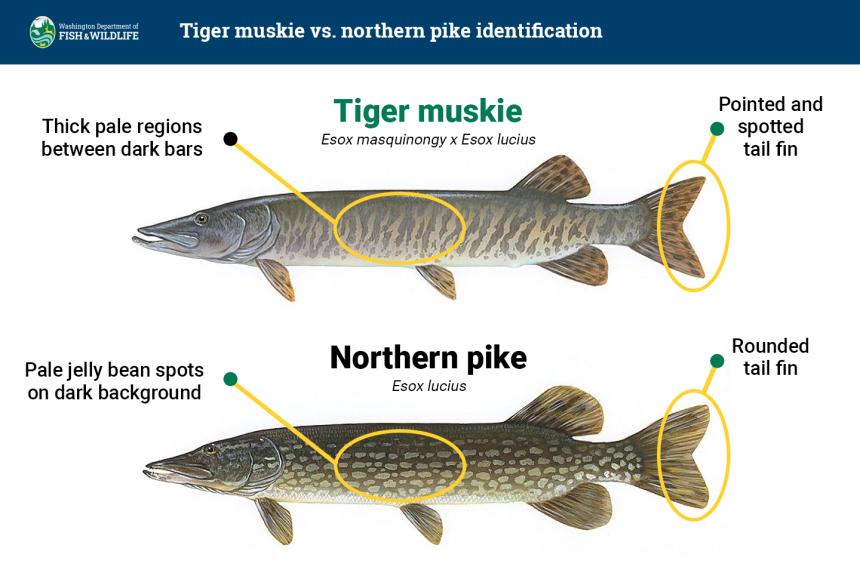April 2024: WDFW removing invasive pike after illegal introductions on San Juan Island and in Lake Washington
If anglers catch northern pike in new areas, WDFW asks that they kill the pike immediately and do not release it, take a photo, and report it by calling 1-888-WDFW-AIS, email at ais@dfw.wa.gov, or use the Washington Invasive Species Council reporting form or mobile app at invasivespecies.wa.gov/report-a-sighting.
The northern pike (Esox Lucius) is a non-native fish classified as a prohibited aquatic invasive species (AIS) in Washington. It has already spread to several water bodies within the state.
Illegal stocking in the 1950s in Montana rivers and in the 1970s in the Coeur d’Alene river system led to establishment of northern pike in the upper Columbia River Basin. Since then, the species has steadily expanded downstream to include the Pend Oreille River, Spokane River, and the Columbia River upstream of Grand Coulee Dam. Northern pike have also been introduced to Lake Washington in King County and have been found in a pond on San Juan Island.
Their voracious appetite for other fish and prolific spawning habits represent a potential for great ecological and economic damage, not just in northeast Washington but throughout the region. Northern pike can live over 20 years, can grow to more than 45 pounds, produce a large number of young, and can consume substantial quantities of native and Endangered Species Act (ESA)-listed salmonids that are particularly vulnerable to predation.
Surveys conducted between 2004 and 2014 documented both a rapid increase in the number of northern pike in Box Canyon Reservoir and a decline in the abundance of forage species such as native minnows and non-native sunfish, largemouth bass, and yellow perch.
Or learn more about northern pike in Washington in our printable brochure (PDF) (2023 version).
Invasive species information
Other western states are struggling with non-native populations of Northern Pike as well, and face challenges similar to Washington. Alaska, for example, has a large northern portion of the state where Northern Pike are native, but illegal introductions to the southcentral part of the state, where they are not native, have caused devastating impacts to native salmon and trout populations. Washington is trying to learn from Alaska’s management strategy, and for more information on their situation, see the Alaska Department of Fish and Game Northern Pike webpage.
Northern Pike Reports
- State of Washington Interagency Northern Pike Rapid Response Plan (2023)
- 2022 Box Canyon Supression Summary Report
- 2022 Boundary Reservoir Suppression Summary and SPIN Results Report
- 2021 Box Canyon Supression Summary Report
- 2021 Boundary Reservoir Suppression Summary and SPIN Results Report
- 2020 Box Canyon Supression Summary Report
- 2020 Boundary Reservoir Suppression Summary and SPIN Results Report
- 2019 Box Canyon Supression Summary Report
- 2019 Boundary Reservoir Suppression Summary and SPIN Results Report
- 2018 Box Canyon Supression Summary Report
- 2018 Boundary Reservoir Suppression Summary and SPIN Results Report
- 2017 Box Canyon Supression Summary Report
- 2017 Boundary Reservoir Suppression Summary and SPIN Results Report
- 2016 Suppression Summary Report
- 2015 Suppression Summary Report
- 2014 Suppression Summary Report
- 2013 Suppression Summary Report
- Warmwater Fisheries Surveys of Box Canyon Reservoir Pend Oreille County, Washington 2004 - 2009 - 2011
- 2004 Warmwater Fisheries Survey of Box Canyon Reservoir, Pend Oreille
- Suppression of Northern Pike in Box Canyon Reservoir, Pend Oreille River
- Development of a Target Abundance for Northern Pike in Box Canyon Reservoir
- Spring Pike Index Netting (SPIN) Box Canyon Reservoir
Description and Range
Physical description
Northern pike have a long body shape, oval in cross-section (hence the name “pike”, meaning spear or lance-shaped) and have a large duck-bill mouth with big teeth and a dorsal fin located near the tail fin. They display horizontal rows of light-colored round to oval spots on a dark background.
The following infographic shows ways of distinguishing invasive northern pike from sterile tiger muskie.

Geographic range
The largest proportion of northern pike in the Pend Oreille River is in Box Canyon Reservoir, but they also live in Boundary Reservoir, just north of Box Canyon Dam on the Pend Oreille River. Anglers have also reported catching pike in the Columbia River north of the confluence with the Pend Oreille River, in Canada, downstream near Northport, Washington, and just upstream and downstream of Kettle Falls. They also live in the Spokane River from Lake Couer d’Alene in Idaho downstream to Long Lake in Spokane County.
Northern pike have also been illegally introduced in Lake Washington in King County and Carefree Lake on San Juan Island. Northern pike are a prohibited species everywhere they exist in Washington. It is illegal to retain or transport live pike in our state.
Regulations
Rules and seasons
If anglers catch northern pike in new areas, WDFW asks that they kill the pike immediately and do not release it, take a photo, and report it by calling 1-888-WDFW-AIS, email at ais@dfw.wa.gov, or use the Washington Invasive Species Council reporting form or mobile app at invasivespecies.wa.gov/report-a-sighting/.
Under Washington state regulations, prohibited invasive species may be immediately killed and retained only if the person is certain about species identification and assumes responsibility for correct identification and adherence to state rules and fishing regulations.
Where you may encounter northern pike
Lakes where this species may be found
State record
- Weight
- 34.06 lbs
- Angler
- Bryan McMannis
- Location
- Long Lake, Spokane County
- Date Caught
- April 9, 2004
